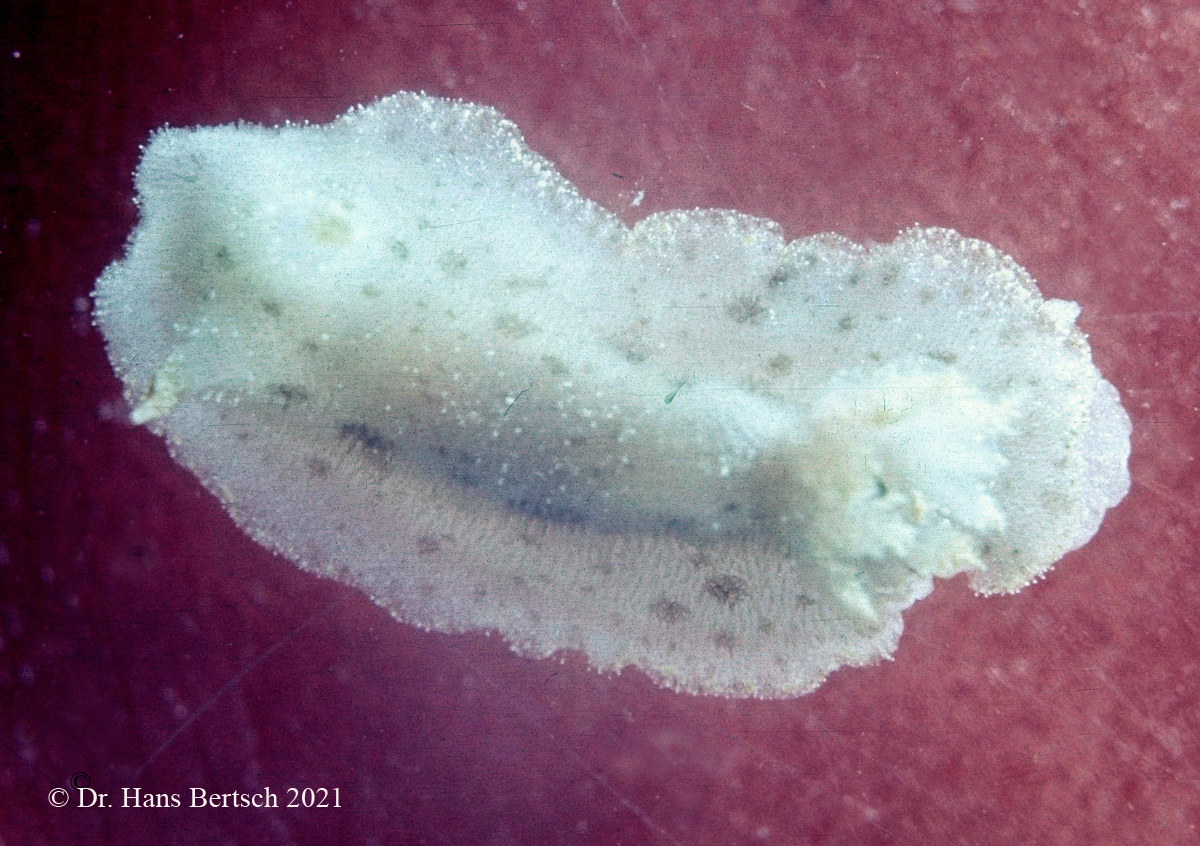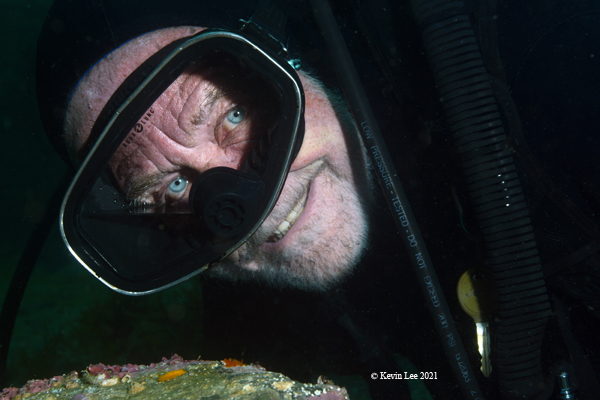 |
Photo by Hans Bertsch, 20 July 1969
Las Cruces, Baja California Sur
10 mm long animal
.
Jorunna osae Camacho-García & Gosliner, 2008
This species was named from individuals collected in the Osa and Tempisque Conservation Areas (8º 37' to 10º 13' N), Pacific coast of Costa Rica. Additional records outside Costa Rica (Bertsch, 2014) extended its range to Bahía de los Ángeles (BLA), Baja California.
Many years before, I had found the species at Las Cruces (24º 12' 42" N; 110º 04' 57" W) which at the time I considered just another unidentified small greyish dorid. While Neil Armstrong and Buzz Aldrin were sitting on the moon in the Apollo Lunar Module Eagle waiting for their “giant step” on the surface, I was photographing nudibranchs at Bing Crosby’s resort villa. Bing’s wife, Katherine, had let Dr. Rita Schafer of Immaculate Heart College (Los Angeles) use the home as a marine station during that summer, and I spent a month there studying the heterobranchs of the southern Gulf of California, finding a number of new species, including Felimida baumanni (Bertsch, 1970) and Phidiana lascrucensis Bertsch & Ferreira, 1974. Lacking a Nikonos, and only snorkeling and searching intertidally, I was restricted to “tub shots.” Camera gear and set up was extremely primitive, although I did manage an antero-dorsal photo of the animal; depth of field was poor, but one can see the distinctive mantle glands.
Since then, I have found the species at Bahía San Carlos, Sonora, and at Punta la Gringa, Bahía de los Ángeles, Baja California.
The 13 mm Sonoran animal was found intertidally on 25 December 1970. I had accompanied Terry Gosliner and Gary Williams and their brothers on this winter trip. The 7 mm BLA animal was found subtidally (4.3 m deep) while scuba diving on 13 February 2014 with Mike Miller, our “Fearless” Webmaster.
Descriptive Notes. The elongate, oval body reaches at least 13 mm in living length. The dorsum is covered with elongate caryophyllidia, which have a conical base and long spicules. Body color pale cream, with light yellow-brown patches or spots that are darker in some specimens. White glandular structures occur along the mantle edge. It can be distinguished from its sympatric congener Jorunna tempisquensis Camacho-Garcia & Gosliner, 2008, by the presence of mantle glands (lacking in J. tempisquensis) and erect gills (rather than the spreading gills of J. tempisquensis).
Studies at Bahía de los Ángeles. For the past several decades, I have taken advantage of the fact that the Gulf of California is fairly well accessible to me. My ongoing long-term studies at BLA have resulted in the discovery of numerous new species (see Bertsch, 2018, and Gosliner & Bertsch, 2017) and the collection of data on the natural history of heterobranchs (see Bertsch, 2019).
At the end of August, I gave a video-conference talk to the San Diego Shell Club, entitled “Heterobranchia of Bahía de los Ángeles: A Review of their Research History, Biodiversity, and Natural History.” This virtual presentation was recorded, and can be viewed and listened to here. The talk is about 50 minutes long. So grab a cup of coffee, or knowing that somewhere in the world it is after 5 pm, mix a cold margarita, and enjoy!
Webmaster's Notes:
We most gratefully acknowledge the marvelous assistance of Robyn Waayers, Corresponding Secretary of the San Diego Shell Club. She provided the technological know-how to host the original 23 August zoom meeting of Hans' talk, recording it, and then arranging for us to link to and present it on the Slug Site. Thank you Robyn!!!
References
Bertsch, Hans. 2014. Biodiversity in La Reserva de la Biósfera Bahía de los Ángeles y Canales de Ballenas y Salsipuedes: Naming of a new genus, range extensions and new records, and species list of Heterobranchia (Mollusca: Gastropoda), with comments on biodiversity conservation within marine reserves. The Festivus 46 (5): 158-177.
Bertsch, Hans. 2018. A history of people, slugs and type localities at Bahía de los Ángeles, Gulf of California: some recollections. The Festivus 50 (3): 179-197.
Bertsch, Hans. 2019. Biodiversity and natural history of Nudipleura communities (Mollusca, Gastropoda) at Bahía de los Ángeles, Baja California, Mexico. A 30-year study. Geomare Zoológica 1: 89-136.
Camacho-García, Yolanda E. & Terrence M. Gosliner. 2008. Systematic revision of Jorunna Bergh, 1876 (Nudibranchia: Discodorididae) with a morphological phylogenetic analysis. Journal of Molluscan Studies 74: 143-181.
Gosliner, Terrence M. & Hans Bertsch. 2017. Two new species of nudibranch mollusks from the tropical Eastern Pacific of Mexico. Proceedings California Academy of Sciences, Ser. 4, 64 (6): 117-130.
Dr. Hans Bertsch
Imperial Beach, Calif
Sept., 2021
Send Hans email at hansmarvida@sbcglobal.net

|
and orangish Doriopsilla davebehrensi on the rock below.
Image courtesy of Kevin Lee
